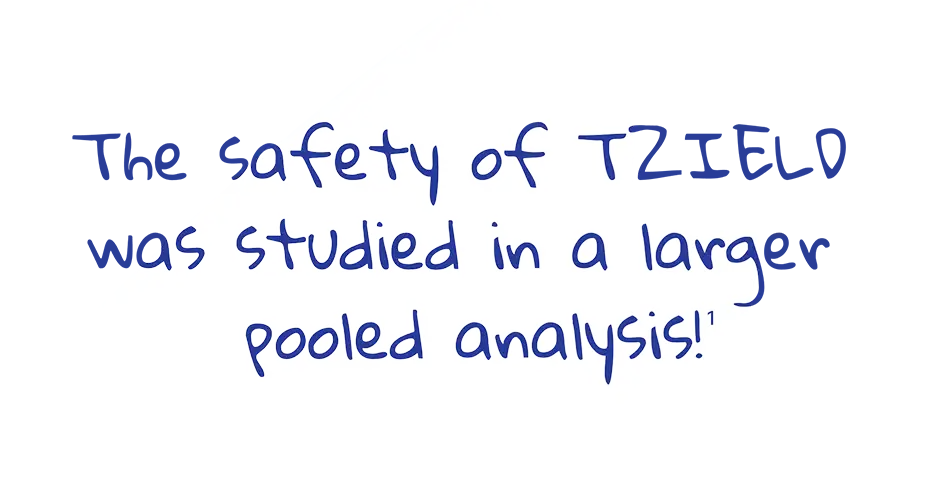COMMON ADVERSE REACTIONS
Common adverse reactions (ARs)* in the TN-10 trial1†
Reactions
(N=32)
(N=44)
*Adverse reactions that occurred in 2 or more TZIELD-treated patients.1
†That occurred during treatment and through 28 days of the last TZIELD administration.1
‡Composite of rash-related terms including rash erythematous, rash macular, rash papular, rash maculo-papular, rash pruritic.1
Greater incidences of ARs observed in TZIELD-treated patients vs placebo-treated patients recorded throughout the study1,2:
- Cytokine release syndrome (2% vs 0%, respectively)
- Serious infections§ (9% vs 0%, respectively)
- Hypersensitivity reactions; serum sickness (2% vs 0%, respectively)
- Lymphopenia (73% vs 6%, respectively)
- Neutropenia (7% vs 3%, respectively)
§Serious infections included cellulitis, gastroenteritis, pneumonia, and wound infection anytime during or after the first dose of study treatment.1
Safety Summary
LYMPHOPENIA IN TN-10
Lymphopenia in TN-10 trial
Most instances of lymphopenia with TZIELD recovered by Week 6.1
Lymphopenia occurred in absence of T cell depletion.1
TZIELD was not commonly associated with the symptomatic reactivation of EBV or CMV.3*
Monitor white blood cell counts during the treatment period. If prolonged severe lymphopenia (<500 cells per mcL lasting 1 week or longer) develops, discontinue TZIELD.1
CMV=cytomegalovirus; EBV=Epstein-Barr virus.
*One TZIELD-treated patient in Study TN-10 reported symptoms consistent with reactivation of EBV.3
Epstein-Barr virus (EBV)
Of 16 patients with EBV antibodies in the TZIELD group, 8 had quantifiable EBV DNA in whole blood at Week 3 through Week 6. EBV DNA levels decreased to below the level of quantification between Day 43 and Day 134 (mean Day 77).
Cytomegalovirus (CMV)
Of 10 patients with CMV antibodies in the TZIELD group, one had detectable levels of CMV DNA at Day 20. CMV DNA was undetectable by Day 42.
In TN-10 trial: average absolute lymphocyte counts in treatment groups (TZIELD and placebo) during first 6 weeks after initiating treatment1,3†
In TN-10 trial: average absolute lymphocyte counts in treatment groups (TZIELD and placebo) during first 6 weeks after initiating treatment1,3†
WARNINGS & PRECAUTIONS
Additional warnings and precautions
Cytokine release syndrome (CRS)
Premedicate, monitor liver enzymes, discontinue in those that develop elevated alanine aminotransferase or aspartate aminotransferase more than 5 times the upper limit of normal, and if severe CRS develops consider temporarily pausing dosing. CRS manifestations in TZIELD-treated patients included fever, nausea, fatigue, headache, myalgia, arthralgia, increased alanine aminotransferase (ALT), increased aspartate aminotransferase (AST), and increased total bilirubin.1
Serious infections
Use of TZIELD is not recommended in patients with active serious infection or chronic infection. Monitor for signs and symptoms of infection during and after TZIELD treatment. If a serious infection develops, discontinue TZIELD.1
Vaccinations
Administer all age-appropriate vaccinations prior to starting TZIELD. See recommendations regarding live-attenuated, inactivated, and mRNA vaccines.1
Hypersensitivity reactions
If severe hypersensitivity reactions occur, discontinue TZIELD and treat promptly. Acute hypersensitivity reactions including serum sickness, angioedema, urticaria, rash, vomiting, and bronchospasm occurred in TZIELD-treated patients.1
See WARNINGS AND PRECAUTIONS (section 5.0) in the Prescribing Information for TZIELD to learn more.

POOLED SAFETY
Pooled safety analysis of 5 controlled clinical studies
In the pooled analysis, adverse reactions were evaluated in 773 TZIELD-treated patients, and 245 patients received placebo or standard of care (1 study in patients with Stage 2 T1D [Study TN-10], 3 placebo-controlled studies in an unapproved population, and 1 open-label standard-of-care controlled study of TZIELD in an unapproved population).1
